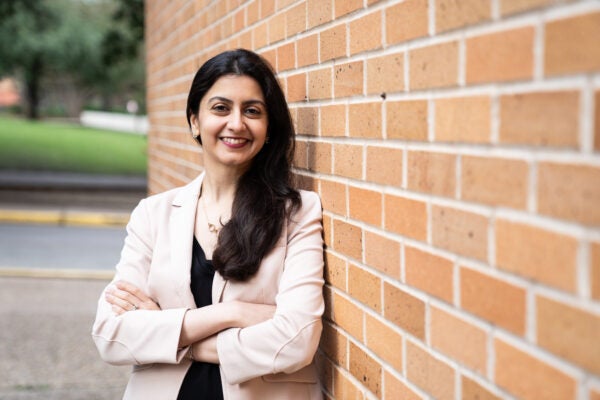Ripped From the Headlines
By bringing news into the classroom, Teaching Fellow Srinivasan’s students gain sought-after business skills

As a self-proclaimed news junkie with decades of experience preparing Texas McCombs School of Business students for executive careers, Professor of Marketing Raji Srinivasan recognizes that increasing reliance on “news-tainment” from social media is hurting students’ job readiness.
“I’m teaching 22-year-olds who are mostly getting news from TikTok or Facebook or Instagram. Some of it comes from bots, from AI. It’s fake news. It’s not credible,” says the professor who joined Texas McCombs in 2000. “It’s disappointing.”
To counterbalance this trend, Srinivasan began several years ago to bring topical marketing news articles into her classrooms for discussion and analysis. The simple but profound innovation caught her colleagues’ attention, and she hoped that by honing her approach as a Teaching Fellow for 2024-2025, she could help other educators.
“I enjoy teaching, and I wanted to develop this idea as a guide. It works especially well for the marketing capstone class for undergraduate marketing majors, but it also works in undergraduate and master’s electives,” she says.
Practical business literacy
“I force these students to think outside the box by reading long-form articles, not 30-second videos,” she says, noting her students are sometimes reluctant at first because many of them don’t have a reading habit. “It’s a little bit of a pain, but once they start reading and we have these timely discussions in the classroom, they learn from each other.
“They engage with real-time business problems, enhancing their critical thinking, decision-making, communication, and ethical reasoning.” Students also gain practical business literacy by becoming familiar with the tone, framing, and analytical depth of professional publications, she says.
These are skills future employers value.
“Being a Fellow benefits me personally. It forces me to think about all aspects of my teaching, even weaknesses, and to articulate my approach to others.”
— Raji Srinivasan, McCombs Teaching Fellow, 2024-2025
Exploring and fine-tuning as a Teaching Fellow
Through her Teaching Fellows experience, Srinivasan began composing a detailed primer on her news-meets-theory perspective. She says defending and explaining her ideas for advisers and colleagues has helped her think through challenges and solutions with her instructional approach. “It can be subtle, but I’m planning to implement some changes next semester because of what I’ve learned. For example, I am going to introduce role-playing in the classroom to mimic the protagonists in the article to further enhance students’ learning.”
Studying the news in the classroom
Srinivasan orchestrates class discussions based on readings and encourages thoughtful disagreement. Not everyone agrees on theories or even on the reliability of sources, which may include The New York Times, The Wall Street Journal, The Washington Post, and the Financial Times. She sometimes uses company press releases distributed by PR Newswire.
“I’m a high-energy teacher, and I try to pull out comments and opinions. I like my classes to be interactive, and I’m OK with a little bit of chaos in the classroom.”
Inevitably, politics will enter the discussions, she says. But the same is true in the workplace her students are preparing for. “I tell them you can’t just escape,” she says. “You’re going to go into the world, and these are the big issues. You need to learn how to manage.
“Once in a while, we get to a point where I say, OK there’s the politics part and the business part. Why don’t we discuss the business first?”
Practicing critical thinking and communication
“Raji’s approach is much more than simply getting students to read business news articles,” says Brandon Campitelli, assistant director of the McCombs Office of Instructional Innovation.
Each capstone course section guides 25-30 juniors and seniors from theory to workforce readiness by practicing communication and teamwork, and analyzing ambiguous situations. Srinivasan splits the class into smaller breakout groups, assigning them to study certain articles before class and discuss them during the class period. She also implements group projects based on news articles.
For example, a Wall Street Journal article, “Dollar Stores Are Flashing a Warning Sign About Lower-Income Consumers,” was used for an in-class assessment of the threat to the retailer. Students were asked to provide two strategic marketing suggestions based on the situation.
“Her method cultivates the critical thinking and problem-solving skills that employers seek in our graduates,” Campitelli adds.
Better trained for the workplace
Srinivasan sees a shift as students begin to see themselves as emerging professionals capable of engaging in real-world challenges. They are motivated to develop a lifelong habit of staying informed.
Student feedback is positive, with praise for “the incorporation of current events into the related course materials and the open discussions on the pros and cons of different types of news sources.”
Another student added, “Everything felt so relevant and fresh and applicable to everything I see in the world.”
Looking ahead
Srinivasan says she will continue to bring contemporary business challenges into her classes and is working to provide details and inspiration for other educators. She and Campitelli are preparing a scholarly article to submit to national higher education publications, hoping to spread the concepts beyond Texas McCombs.
Story by Sandra Kleinsasser
About this Post
Share:


